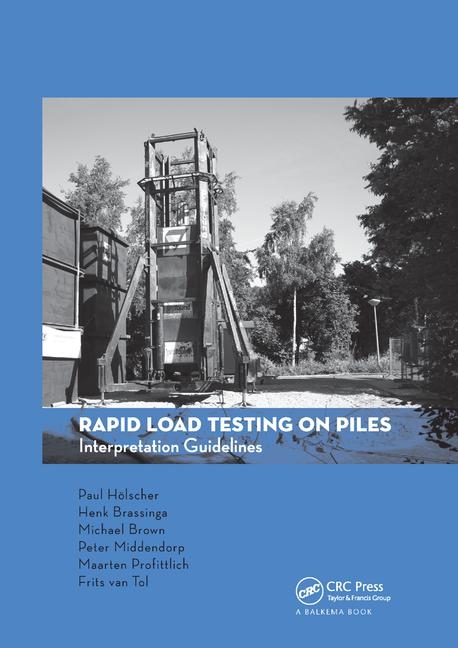
Rapid Load Testing on Piles
CRC Press (Verlag)
978-1-138-11377-0 (ISBN)
A Rapid Load Test (RLT), developed to determine the initial stiffness and bearing capacity, is an economical and practical alternative to a Static Load Test (SLT). The broad application of RLT, however, was hampered by uncertainty about the interpretation of the test results. This book offers clear guidance on the available analysis techniques and their reliability.
The guidelines were related to an international standard that is drawn up by CEN and can be used in two ways:
Straightforward interpretation of test results, chapters 1-3
Interpretation with additional background information about the possibilities and limitations, chapters 4-8
The guidelines were drawn up by the Dutch CUR-committee on rapid load testing on piles.
Chapters 1 and 2 deal with the practical execution of the test and the presentation of the results. Chapter 3 gives a general overview of existing interpretation methods and refers to step-by-step descriptions of the two advised interpretation methods.
The aspects that are important for the interpretation are discussed in chapter 4, also showing that the inertia of the pile should be taken into account. In clay soil the rate effect (the dependency of strength and stiffness on loading rate) is also of importance, whereas in sand and silt the generation of pore water pressures during an RLT plays a role. The velocity of the RLT is such that the reaction of sand and silt might be considered as partially drained. These guidelines indicate how these effects can be compensated to obtain the static resistance in the final results.
Chapter 5 presents two interpretation methods (a method for piles in sand, gravel, silt and piles on rock and a method for piles in clay). For practical use, the methods are described in a step-by-step scheme in an appendix.
Paul Hoelscher is a specialist in the application of soil dynamics to practical problems in urban engineering. He obtained his doctorate from Delft University of Technology on the dynamic behaviour of dry and saturated soil. In his 25-year career he worked at Deltares on both fundamental research as well as practical problems for geotechnical engineers.
Henk Brassinga is senior consultant of the engineering division of the city of Rotterdam. He has been involved in many large projects in Rotterdam Harbour.
Mike Brown is currently a lecturer at the University of Dundee. He obtained his doctorate from the University of Sheffield on the rapid pile testing for piles in clay.
Peter Middendorp is director of Allnamics. He contributed to the development of pile driving analysis and the Statnamic test method. He created the basics of unloading point method and has been involved in many large rapid pile tests.
Maarten Profittlich is a consultant at Fugro. He is involved in design and testing of foundation piles worldwide. Fugro owns one of the biggest Statnamic devices world wide.
Frits van Tol is a professor of Foundation Engineering at Delft University of Technology and expertise manager at Deltares.
Preface
Summary
1 Introduction and scope of the guidelines
2 Test execution and test results
3 General overview of interpretation methods
3.1 Introduction
3.2 Relevant aspects for the interpretation
3.2.1 Inertia effects
3.2.2 Rate effects
3.3 Description of interpretation methods
3.3.1 General
3.3.2 Choice of method
3.3.3 Short description of the Unloading Point Method
3.3.4 Short description of the Sheffield method
3.3.5 Methods with more degrees of freedom
3.4 Safety approach
4 Theoretical aspects
4.1 Introduction
4.2 The inverse problem
4.3 Dynamic effects
4.3.1 Inertial effects for closed piles
4.3.2 Inertial effects for open ended pipe piles
4.3.3 Damping effects
4.4 Rate effects
4.4.1 General meaning of rate effect
4.4.2 Measuring and modelling the rate effect
4.4.3 Constitutive rate effect in dry sand
4.4.4 Rate effect in clay
4.4.5 Pore water pressures in saturated sand
4.5 Combined effects
5 Interpretation methods
5.1 Introduction
5.2 Unloading point method
5.2.1 Definition of the method
5.2.2 Measurement / estimation of required parameters
5.2.3 Example of the application
5.3 Method developed at Sheffield
5.3.1 Definition of the method
5.3.2 Measurement or estimation of required parameters
6 Safety approach
6.1 Method
6.2 Partial factors
7 Special aspects
7.1 Open-ended piles
7.2 Influence of pile installation
7.3 Layered soils
7.4 Other aspects
8 Symbols and definitions
8.1 Symbols
8.2 Definitions
| Erscheinungsdatum | 04.07.2017 |
|---|---|
| Verlagsort | London |
| Sprache | englisch |
| Maße | 171 x 248 mm |
| Gewicht | 200 g |
| Einbandart | kartoniert |
| Themenwelt | Technik ► Bauwesen |
| Technik ► Bergbau | |
| Technik ► Maschinenbau | |
| Technik ► Umwelttechnik / Biotechnologie | |
| ISBN-10 | 1-138-11377-8 / 1138113778 |
| ISBN-13 | 978-1-138-11377-0 / 9781138113770 |
| Zustand | Neuware |
| Haben Sie eine Frage zum Produkt? |
aus dem Bereich


